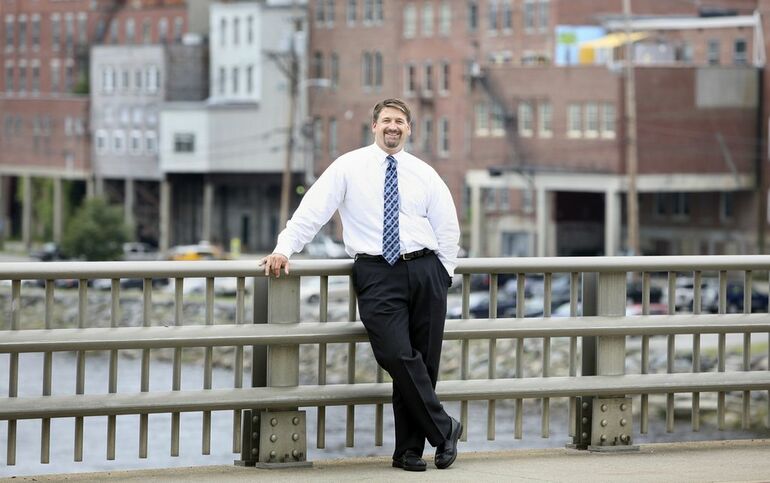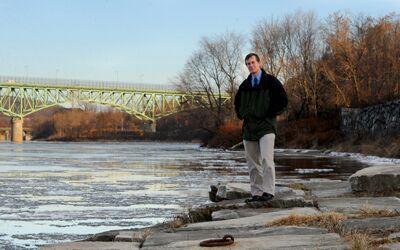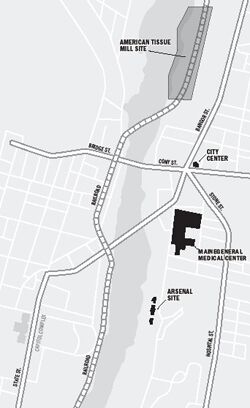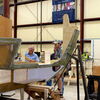Augusta eyes a renaissance along the river
It's about two miles from Augusta's southern border, running along the eastern bank of the Kennebec River to the bridge that carries Route 3 high above the water. By 2014, nearly all that river frontage will be available for development or redevelopment. Depending on your point of view, that is either a golden opportunity or a daunting challenge to the resources of a state capital with fewer than 20,000 residents.
Mike Duguay, Augusta's economic development director, sees the opportunity. "This really is a once-in-a-lifetime opportunity to reshape the way Augusta works," he says.
The main components in Augusta's potential East Side renaissance are, from south to north, the Kennebec Arsenal property, MaineGeneral's soon-to-be-vacated hospital and the former paper mill site that goes by various names. The sites total 70 acres, and each one has several thousand feet of riverfront.
In the middle is the "new" city hall, built in 1989, the old city hall, now housing for the elderly, and Olde Fort Western, a historic site where Benedict Arnold's Revolutionary War expedition to Quebec was launched.
Augusta's development has long been weighted toward the West Side, which has federal, state and county government complexes, the downtown (Water Street) and Western Avenue shopping areas, and two newer malls along Interstate 95, at Exits 109 and 112.
Now, the hospital is moving there, with a $322 million facility scheduled to open in 2014 at Exit 113.
Matt Nazar, the city planner, sees the scale of the East Side revitalization as a chance to rebalance the city's core development — though probably not all at once.
"The reality is that, in other states, you might hire a single developer who would try to take on the entire site," Nazar says. But that's not the way things work in New England, particularly northern New England.
"Our firms tend to specialize in one kind of development — housing, office, retail or industrial," he says. "It's rare that anyone tries to take on all that at once."
That may be a good thing, Nazar says. A step-by-step approach may enable Augusta to come up with projects that are less disruptive to existing neighborhoods and don't flood the market with new space during a still-tentative recovery from the economic slump that began in 2008.
Arsenal site key to future
The first blueprint for a renewed East Side was released in October. The 11-member Eastside Planning Committee's 23-page report covers everything from the lagging redevelopment of the Kennebec Arsenal to a scrap yard in the middle of the targeted area, from the future of the city's snow dump beneath Memorial Bridge to new road access to the paper mill site — once Hudson Paper, then Statler and American Tissue before operations ceased in 2007.
Ward 2 City Councilor Darek Grant, who chaired the committee, says residents in the East Side neighborhoods view the hospital's pending departure with both hope and anxiety.
"They see this as a chance to reclaim their neighborhood from the traffic and congestion it now experiences," he says. "But they worry about having another big vacant building that could become an eyesore."
Such concerns have been stoked by the city's thus-far unhappy experience with the developer chosen as custodian of the arsenal, a state-owned property that was conveyed to North Carolina developer Tom Niemann in 2007 for $1.
The deal featured the first-ever state tax credit for redevelopment of historic buildings, under legislation sponsored by then-Senate Majority Leader Elizabeth Mitchell. The tax credit has since been expanded statewide.
While 19th century buildings elsewhere have been brought back to life, the arsenal sits vacant. "The neighbors are asking questions," Grant says. "They're concerned."
Mayor William Stokes gives a blunter assessment. "People are angry. They don't think the buildings are even being protected against vandalism."
Stokes and City Manager William Bridgeo met recently with Neimann, whose properties have had financial difficulties in both Maine and North Carolina. Bridgeo emerged with a guardedly optimistic assessment.
"Some of the problems he's been having in the face of the real estate meltdown seem to have eased," he says. "We would like him to make good on his promises to the city of Augusta."
Bridgeo says Niemann is "technically in default" on his tax increment financing deal with the city, which rebates 100% of the property taxes to the developer for 10 years, but only if Niemann moves ahead with redevelopment.
Nazar says the arsenal is "without doubt the keystone property for the whole area." Its stone structures are directly across the Kennebec River from Capitol Park and the State House, and clearing of trees and brush along the river has restored access to the arsenal's old wharf.
"It's still a premier site for a mixed-used development, and a great place for people to bring their boats," Bridgeo says. "Hallowell and Gardiner now have great (boating) access to the Kennebec, but Augusta's is limited."
The main arsenal building has 4-foot-thick granite walls, and redeveloping it will be costly; most assessments suggest that Niemann would have to add new, compatible structures to achieve a reasonable per-unit cost. "But first he's got to come through with a plan," Bridgeo says. If the project remains stalled, the planning committee recommends that the city investigate having the state take back the property.
New hospital challenges
The MaineGeneral site, which was Augusta City Hospital before mergers with hospitals in Gardiner and Waterville, presents a different array of challenges. Nazar says, "It's really unusual to see a purpose-built structure of this size [250,000 square feet on multiple floors] re-used intact."
The committee came up with a number of possible uses — including housing for the elderly or assisted living, or a private college campus — but nothing emerged as a top contender.
Then there's the question of whether, even if the hospital building could be reused, it should be. Nazar says that over the years, MaineGeneral grew dramatically, with numerous additions that eventually made it dwarf the densely built neighborhood around it. One concept the committee discussed is partially or completely demolishing the hospital, using that area for a parking garage and developing the riverfront parcels the hospital has used for expanded parking in recent years.
Duguay says the city could be even bolder. "I'd like to see us design something like the promenades in Portland, with green space that would allow people to reconnect to the river," he says. "That's really what makes projects like this go."
And, he says, it's a popular idea. Public space along the Kennebec "is probably what residents of Augusta want most."
While Augusta escaped major urban renewal in the 1960s and '70s, it was increasingly rebuilt to accommodate vehicles, not pedestrians, Duguay says. He praised some of the ideas that neighbors offered the committee, such as corkscrew stairways to provide access from Arsenal Street to Memorial Bridge, which was re-decked recently with wide sidewalks that still get little use.
Perhaps the biggest pedestrian improvement envisioned in the plan — one that Grant says "has really captured people's attention" — is reopening the unused railroad bridge just north of the Calumet Bridge for bicycling and walking. Since it's a double-track trestle, it could have a pedestrian corridor and still allow trains to pass, Bridgeo notes.
The railroad bridge could allow connections and circulation throughout the downtown area, Nazar says, building on the popularity of the Kennebec Rail Trail, which runs south to Hallowell, Farmingdale and Gardiner, but now ends at the base of Memorial Bridge on the West Side.
The plan considers other impediments to reuse, such as the city's snow dump under the bridge, which cuts off access between the hospital property and Olde Fort Western for seven months of the year.
"Relocation has been suggested before," Bridgeo says. "It's mostly a matter of the cost" — an estimated $50,000 a year more for trucking snow. Grant says the committee recommends removing the snow dump as a good-faith gesture showing the city's commitment to redeveloping the riverfront.
New ties to the river
Finally, there's the paper mill site, which has been cleaned up and is available for redevelopment, with nearly a half-mile of riverfront. The cleanup was less arduous than for many old mills, in part because the mill used only recycled stock for the last 40 years of its operation.
"It's well above the floodplain, it's flat and it's completely open," Bridgeo says, enumerating the site's advantages. "And it's got absolutely great views."
Nazar concurs. "Properly sited, apartments and townhouses there could provide views all the way up and down the river," he says. "It really could bring people into a new relationship with the river corridor."
Adds Duguay, "That's what we hope will sell."
One Steel, which operates the scrap yard at the south end of the paper mill site, has been approached about relocating, "and is willing to listen to an offer," Bridgeo says.
In Duguay's view, the Kennebec Valley's topography reduces the urgency of moving the scrap yard.
"Normally, the steep slopes along the river are a big problem for development, but in this case they help us," he says. New development along Bangor Street, which parallels the river, "could look over the site and hardly see it," he says.
Still, if the paper mill site is eventually to be tied back to the downtown, via Willow Street along the river, the scrap yard will have to go.
The mill site doesn't have significant road access. That's a problem the East Side plan says could be remedied by a new road from the intersection of Bangor Street and North Belfast Avenue, starting alongside the fire station. "There's already a traffic light there," says Nazar, "and though the road would have to wind down the slope, it does look doable."
The big question is whether, and when, new uses will be found for all, or any, of this two-mile stretch of the river. Nazar says, "Realistically, this isn't one project, but a series of them. It will have to grow over time."
Still, says Mayor Stokes, "It's a nice problem to have. Very few cities even of Augusta's size have the opportunity to make over the core of the urban area."
While the current economic climate is more favorable to planning than building, Stokes says he's seeing "a bit of a thaw when it comes to development." Over the past six months, for instance, developers have taken out 13 building permits for new houses, "and that's not something we'd been seeing at all."
The city council has instructed the city's staff to come up with implementation for the East Side plan and then, Stokes says, "We'll see what happens."
Says Grant, "We're looking for a spark. We really think that once we get that, things could really take off."












Comments